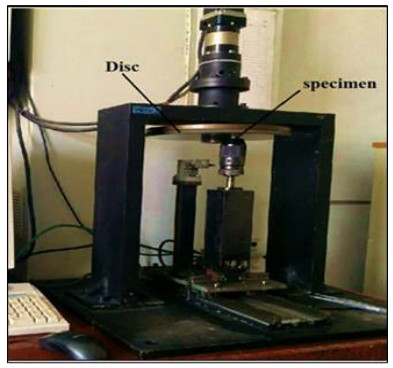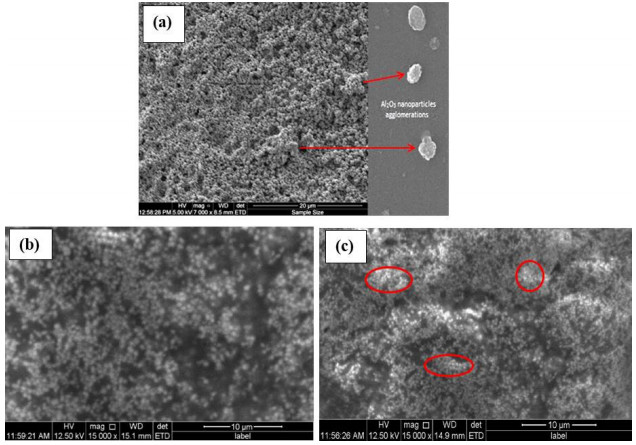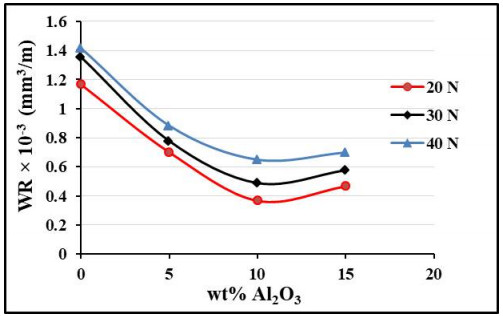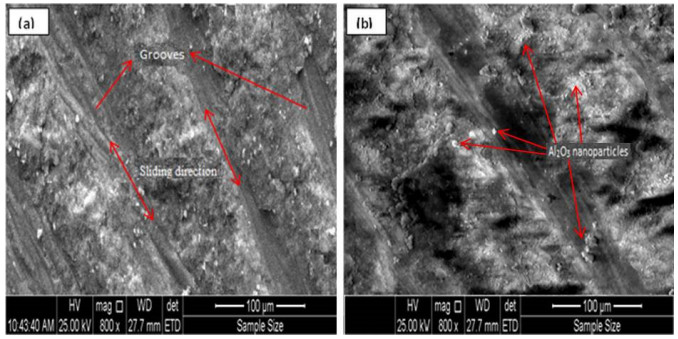The goals of this investigation are the optimization and characterization of Al6061/Al2O3 nanocomposite, which was synthesized by stir casting technique. Different concentrations of Al2O3 nanoparticles as 5, 10, and 15 wt% with an average particle size of 40 nm were examined. The alumina nanoparticles were critically refined and distributed homogeneously in the Al6061 matrix. The microstructure of Al6061/Al2O3 nanocomposite was observed by using scanning electron microscopy. The mechanical properties (tensile, hardness, and ductility) and tribological properties (wear and coefficient of friction) of Al6061/Al2O3 nanocomposites were inspected. The experimental results revealed that there was a significant enhancement in the mechanical properties since it was observed that the yield tensile strength (YTS) increased from 52 to 69 MPa and ultimate tensile strength (UTS) increased from 122 to 158 MPa. The hardness test also showed an enhancement from 28 to 38 BHN at 10 wt% of alumina. The improvement ratios were observed at 32.69%, 29.51%, and 35.71%, respectively. Further, it was found that the incorporation of nano reinforcement can effectively improve the wear rate. It was observed 0.62 × 10-3 (mm3/m) at 40 N of 10 wt% Al2O3 nanoparticles comparison with 1.4 × 10-3 (mm3/m) at the same load of the Al6061 alloy.
1.
Introduction
Efforts have been made to develop a new aluminum (Al) based materials for aerospace and aeronautical applications. Accordingly, Metal Matrix Composites (MMCs) possess a promising material in the recent interest [1,2]. Metal matrix composites (MMCs) preparation consists of the incorporation of either metallic or ceramic of either micro or nanoparticles such as ZrO2, Al2O3, SiC, B4C, or TiO2 which is considered essential to improve the mechanical and tribological properties. In fact, nanocomposites that are prepared by nanoparticles exhibit superior physical and mechanical properties. These efficient properties are attributed to the high specific surface area of nanostructures [3]. Hence, aluminum matrix composites are considered to be more attractive materials, due to their desirable characteristics, such as specific stiffness, thermal conductivity, high wear resistance, corrosion resistance, and low density [1,2,4]. Aluminum alloy-based metal matrix composites (AMMC) is generally used for sliding wear applications, due to their wear resistant properties [5,6,7]. In fact, wear behavior of aluminum matrix nanocomposites is extremely reliant on the strength of the interface between the matrix and the reinforcement nanoparticles [8].
Among Al alloys, Al6061 alloy which is broadly used in various applications such as aircraft, automobiles, defense, and marine areas, due to the high strength, lightweight and corrosion resistance [7,9]. However, this alloy is rather soft and reactive as well as requiring finishing treatments to obtain sufficient resistance to both corrosion and wear [7,10,11].
A proper technique is essentially required to refine the microstructure and homogeneous dispersion of reinforcements nanoparticles on metallic surfaces, since the cluster, uneven distribution and poor mutability are the main problems associated with fabrication of these nanocomposites [6]. It is generally accepted that several factors have extremely affected the distribution of the nanoparticles in the base matrix, such as tribological behavior, and uniform synthesizing of the nanoparticles [12]. Hence, techniques such as squeeze or stir casting, spray co-deposition and powder metallurgy have been utilized to fabricate metal matrix composites [12,13].
Stir casting is one of the various manufacturing processes for developing metal matrix composites which are generally accepted as a particularly promising technique and currently practiced commercially. The stir casting technique is used to obtain the suitable dispersion of the reinforcement nanoparticles. The dispersion of the nanoparticles in the matrix material extremely reliant on the quality of mixing, wetting state of the particles with the melt, the rate of solidification and relative density [14].
The mechanical and tribological behavior of nanocomposites has been inspected by several studies. F. Shehata et al. [15], used the mechanochemical technique to synthesize Cu/Al2O3 nanocomposites with a particle size of 50 nm in order to identify the microstructure, microhardness, density, and wear behavior of nanocomposites. It was observed a significant enhancement in the mechanical properties in terms of microhardness, relative density, and abrasive wear resistance of (Cu/30 nm Al2O3) nanocomposites.
Bharath et al. [9], examined the microstructural characterization of the nanocomposites Al6061 metal matrix composite with 6, 9, and 12 wt% of Al2O3 nanoparticles. It was observed a uniform distribution of Al2O3 nanoparticles and the quantity of grain resizing. The tensile and hardness properties were found higher in nanocomposites compared with Al6061 matrix. Additionally, it was found that increasing the addition of reinforcement nanoparticles could be led in the enhancement of the hardness and tensile strength.
D. Aruri et al. [7], investigated the influence of the rotational speed on the wear and mechanical properties of aluminum 6061-T6 alloy surface hybrid composites synthesized by stir processing. Y. K. Singla et al. [16], inspected the wear rate of Al6061 reinforced with SiC/Red Mud/Al2O3 nanoparticles. As expected, there was an obvious reduction in the wear rate as the volume fraction of SiC and Al2O3 nanoparticles increased. While the wear rate exhibited an obvious reduction in the wear rate beyond the 7.5 wt% red mud composition as reinforcement.
M. H. Rahmana and H. M. Mamun Al Rashed [17], studied the microstructure, mechanical properties and wear characteristics of the cast silicon carbide SiC reinforced aluminum matrix composites. It was found that adding SiC reinforced resulted in better hardness, tensile strength and wear resistance than unreinforced Al. H.A. Al-Salihi et al. [18], confirmed that there was a substantial enhancement in the tribological and mechanical properties of the AA7075 nanocomposites with the addition of Al2O3 nanoparticles.
G. Sivakaruna and P. Suresh Babu [19], examined the effects of reinforcement on aluminum metal matrix composites. It was observed that increasing the percentage of reinforcement resulted in the enhancement of mechanical properties and wear resistance. From the above, optimizing the mechanical and tribological behavior for Al6061/Al2O3 nanocomposite is the aim of the present research. The effect of the reinforced Al2O3 nanoparticles with certain particle sizes at different weight fractions on the mechanical and tribological properties of Al6061 alloy was critically examined. The variation in the tribological properties, such as the wear rate and coefficient of friction was sufficiently discussed under different loads, Al2O3 percentages, and sliding distances.
2.
Experimental procedures
2.1. Materials preparation
The materials that was selected for the present investigation to fabricate the composite material are Al6061 alloy as the matrix material and the alumina (Al2O3) nanoparticles as the reinforcement. The chemical composition of Al6061 alloy in the weight percentage is listed in Table 1.
Alumina (Al2O3) nanoparticles with an average particle size of 40 nm and purity of 99.99% were used as the reinforcement phase, which was provided by US Research Nanomaterials, Inc. The physical and mechanical properties of Al6061 alloy and alumina (Al2O3) are shown in Tables 2 and 3, respectively. Different weight percentages of the Al2O3 nanoparticles (0, 5, 10, and 15 wt%) were examined to fabricate Al6061/Al2O3 nanocomposite.
2.2. Nanocomposite preparation
The fabrication of the composite material Al6061/Al2O3 at different reinforcement concentrations (5%, 10%, and 15%) weight percentage was carried out by stir casting technique. A measured amount of alumina Al2O3 nanoparticles was preheated at a temperature of 750 ℃ for 2 h. to make their surfaces oxidized. The raw Al6061 alloy was melted in a graphite crucible using an electrical furnace.
Then, the preheated alumina Al2O3 nanoparticles were added to the melt of Al6061 alloy. The melt of the nanocomposite was stirred for 15 min with a mixing speed of 250 rpm in order to disperse the nanoparticles in the melt. Subsequently, the melted nanocomposite was poured into steel molds and allowed to cool to get the cast rods. The wear test samples were prepared from these cast rods. Stir casting parameters of nanocomposites are shown in Table 4.
2.3. Scanning Electron Microscope (SEM) micrographs
A Scanning Electron Microscope (SEM) was carried out to characterize the microstructure in terms of the distribution of nanoparticles. In fact, SEM was used to observe the morphology and topography of the Al6061/Al2O3 nanocomposite materials with high resolution (micro to nano-scale). The analysis was performed on Mira 3-XMU equipment operating at an accelerating voltage of 15 kV. The standard metallography procedure followed by cloth polishing using emery sheets and a polishing machine were carried out to prepare the specimens.
2.4. Tensile test
The tensile test was carried out at room temperature using a universal tensile testing machine type WDW/200E and a capacity of 200 KN. The tensile test samples were subjected to uniaxial tension until fracture. The standard sample of the tensile test and its dimensions was fabricated according to ASTM (E8/E8-09) [21], as shown in Figure 1. The tensile test specimens were fabricated from cast AMCs with dimensions; 9 mm in diameter, 36 mm in gauge length and were subjected to a crosshead speed of 8 mm/min. For more accuracy of the results of the tests, each condition was examined three times and the average value of the three readings was taken in the interpretation.
2.5. Hardness test
The hardness tests of the composite Al6061 reinforced by Al2O3 nanoparticles with 5, 10, and 15 wt% were performed by the Brinell hardness testing machine. The values of hardness were calculated from the diameter of indentation carried out by a steel ball penetrator with a load of 1.96 N.
2.6. Wear test
Present work used pin-on-disc equipment to investigate the wear characteristics, as shown in Figure 2. All the wear samples were prepared according to ASTM D785-08 standards. The wear track surface was cleaned carefully with acetone on both the wear sample and the disc prior to the test. Meanwhile, the weight of wear samples was taken from a digital scale with high accuracy of ±0.0001 gm before fixing them on the pin holder of the tribometer for the test. The experimental parameters carried out to the tests were sliding speed of 125 rpm, track radius 70 mm, loads of 20 N, 30 N, and 40 N for 10 min and total sliding distance of 550 m at room temperature. The dimensions of the pin samples were 30 mm and 12 mm in length and diameter, respectively. Pin samples and disc surfaces were polished by using abrasive paper (grade 100) to achieve the efficient contact surface between them. The wear rate was determined from the volume loss per unit sliding distance.
3.
Results and discussion
3.1. Scanning Electron Microscope (SEM) micrographs
The scanning electron microscope images of the morphology of the prepared Al6061/Al2O3 nanocomposites are shown in Figure 3. It is evident that the reinforcement of Al2O3 particles into the Al6061 matrix alloy that produced by the stir casting method was implemented uniformly. In fact, this property of AMCs, which caused an increase in the mechanical properties was attributed to the homogeneous distribution and the fine size of Al2O3 particles.
The images reveal photographs of the pure Al2O3 nanoparticles and Al6061 base matrix with some agglomerated nanoparticles. Nanocomposite structures in the nature have a tendency to agglomerate in order to minimize the surface energy of the system.
SEM image (Figure 3b) showed good distribution of the Al2O3 reinforcement phase within nanocomposite. These results attributed to the ultrasonic treatment of the Al2O3 nanoparticles before adding it into the melt material crucible. In addition to the stirrer of the matrix melt before and after introducing the nanoparticles. This procedure acts to diffuse the nanoparticles more homogeneously in the matrix and reduces the agglomerations as much as possible. However, with the Al2O3 particle size 40 nm, the agglomeration tendency between them was strengthened because of the large specific surface characteristics. The 15 wt% Al2O3 particles reinforced composite, the great amount of clustering was occurring with increasing the percentage of Al2O3 nanoparticles, since there are some agglomerations were formed as seen in the image (Figure 3c). The last result was explained the mechanical and tribological behaviors of Al6061/15% Al2O3 nanocomposite sample.
3.2. Tensile test
The stress-strain curve gives the characterization of the mechanical properties and performance of the materials during a tensile test. Figure 4 shows the stress-strain curves of Al6061 as a base matrix and Al6061 after reinforced with 5, 10, and 15 wt% of Al2O3 nanoparticles. There is a significant variation in the curves of nanocomposite materials in comparison with the pure matrix material.
The addition of reinforcement Al2O3 nanoparticles into the matrix material caused an increase in the stability, tensile strength, and hardness of Al6061 based nanocomposites. The reason for that may be attributed to the homogeneous dispersion of the nanoparticles, and the nanoparticles afford an enormous surface area within the matrix material which increases the strength of the interface between the nanoparticles and the matrix material. It was shown that there was a critical alumina content, above or below, which the mechanical and tribological properties of composites were both lowered. The mechanical and tribological properties reach the maximum when the amount of Al2O3 nanoparticles comes to 10 wt% after this amount the mechanical and tribological properties of composites were both lowered. A higher amount of Al2O3 resulted in a smaller interparticle spacing, which caused a negative effect on the sintering of the presence of the rigid particles at surfaces, and accordingly brought the decreasing of the mechanical and tribological properties. Moreover, the clusters formed by the addition of the high amount of Al2O3 act as stress concentration centers. The formation and dispersion of the clusters of nanoparticles within matrix material cause a decrease in the tensile properties. It was also observed in a significant decrease in the elongation at fracture with an increase in the amount of Al2O3 nanoparticles.
Table 5 shows the mechanical properties for the nanocomposites with different amounts of Al2O3 nanoparticles. It is clearly seen the enhancement in all tensile properties. A formation of a cluster of nanoparticles reduces the homogeneity of dispersion hence decreases the tensile properties of the nanocomposites at higher loading levels. Elongation at fracture is related to the ductility of the material, therefore, highly ductile material shows higher elongation values at fracture (the pure Al6061 material) and it reduces when the brittleness increased by adding the hard Al2O3 nanoparticles.
3.3. Hardness test
Table 6 shows the variation of hardness with the addition of Al2O3 nanoparticles into the Al6061 matrix. The alloy Al6061 has ductility and plasticity more than its nanocomposites. The nanocomposites samples of size 40 nm particulates were developed with different weight percentages. The hardness of nanocomposites is increased with the increase of the addition of Al2O3 nanoparticles. An increase in the interaction between the matrix and reinforcement nanoparticles results in enhancing the hardness of composites. Hence, a significant decrease in the ductility of Al6061 nanocomposites was observed with increasing the reinforcing Al2O3 nanoparticles. A total increase of 35.71% in the hardness was observed for Al6061 nanocomposite incorporating 10 wt% Al2O3 nanoparticles.
3.4. Wear behavior
In this study, an attempt was made to investigate the dry abrasive wear characteristics of the Al6061/Al2O3 nanocomposite. Wear tests were conducted under three load levels 20 N, 30 N, and 40 N for a constant slippery speed 125 rpm. It can be seen that the reinforcement nanoparticles significantly affected the wear behavior of Al6061/Al2O3 nanocomposite. The wear rate for AA6061/Al2O3 composite was lower compared to base alloy AA6061.
Figure 5 shows the relationship between the wear rate for different amounts of Al2O3 nanoparticles into Al6061 nanocomposite and various loads, respectively. The addition of Al2O3 nanoparticles into Al6061 matrix alloy decreases the wear rate of the nanocomposites and reaches its minimum value at the amount of 10 wt% Al2O3 nanoparticles. The interaction between the added nanoparticles to the matrix material increases with the increase of the amount of nanoparticles, but when the amount of Al2O3 exceeds the 10 wt%, this will result in a smaller interparticle spacing, which caused a negative effect on the sintering for the presence of the rigid particles at surfaces. Therefore, the nanocomposite material shows the lower wear rate, which decreases with an increase in the percentage of the nanoparticles to 15 wt%.
It can be noticed that there is an extreme decrease in the wear rate at lower load levels and the amount of nanoparticles. At lower loading levels, the Al2O3 nanoparticles diffused uniformly in the base matrix and hence it had higher wear resistance.
In addition, it was observed that there is no significant variation in the wear rate above 10 wt% of reinforcement nanoparticles in the Al6061 matrix.
The images of the surface morphology after the wear test are shown in Figure 6. SEM images Figure 6a, b illustrate the nanocomposite samples with concentrations of 5 wt% and 15 wt% of Al2O3 nanoparticles respectively after exposure to 40 N. Along the wear track, abrasive and adhesion, wear mechanisms are visible, due to the increase in temperature. As the nano Al2O3 content increased in the matrix material that the number of grooves is less as seen in nanocomposite samples of 15 wt% nanoparticles, and more in that of the nanocomposite having 5 wt% nano reinforcement. Moreover, SEM image Figure 6b shows distant and shallowness grooves due to the high concentration of hard Al2O3 nanoparticles within nanocomposite. This absence of grooves proposes that a very small amount of material extracted during wear tests.
3.5. Coefficient of friction
It is well known that the coefficient of friction is a measure of the materials to wear resistance. Figure 7 shows the variation of the coefficient of friction with different concentrations of Al2O3 nanoparticles at various loads. It is clearly seen that Al6061 alloy exhibits a higher coefficient of friction compared with the nanocomposites reinforced with different weight percentages of Al2O3 nanoparticles. This is because of the ductility and softened nature of the Al6061 matrix material.
In fact, the coefficient of friction was increased with the increase of load, and it was decreased with the addition of Al2O3 nanoparticles till a certain amount (10 wt%) and then no further considerable effect can be noticed. A considerable decrease in the coefficient of friction values for the low levels of load and Al2O3 percentages can be seen in Figure 7.
4.
Conclusions
Fabrication of Al6061/Al2O3 composites using the stir casting method was effectively examined the morphological, mechanical and tribological properties. Based on the experimental evaluation, the following conclusions can be drawn:
(1) The mechanical properties (tensile and hardness) of the nanocomposite were increased with increasing the amount of Al2O3 nanoparticles into the Al6061 matrix.
(2) Tribological properties revealed a positive impact with the increase of Al2O3 nanoparticles in the Al6061 matrix since the wear rate of the nanocomposites was significantly less compared to the matrix material. The wear rate of 10 wt% Al2O3 of nanocomposite was approximately half the wear rate of the pure matrix material.
(3) The coefficient of friction decreased with increasing the addition of Al2O3 nanoparticles and reaches the minimum at 10 wt% Al2O3 of the nanocomposite.
(4) Al6061/Al2O3 nanocomposite material at reinforcement 10 wt% Al2O3 nanoparticles can be used in various tribological applications with higher mechanical, tribological properties and stability.
(5) Microstructure analysis of the nanocomposite obviously revealed the uniform dispersion of Al2O3 reinforcement particles in the base matrix Al6061, in particular at the low levels of loading.
Acknowledgments
The authors are greatly indebted to the University of Technology, in particular, the Electromechanical Engineering Department for providing significant support during the experimental work. We also would like to extend our appreciation to the SEM lab and the Nanotechnology Department at the University of Technology for their valuable assistance during the experimental work.
Conflict of interests
All authors declare no conflicts of interest in this paper.









 DownLoad:
DownLoad:










